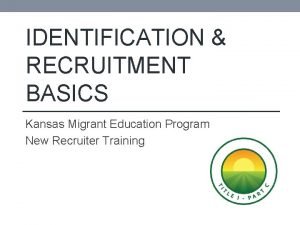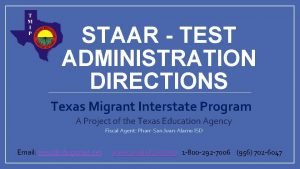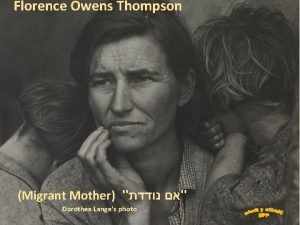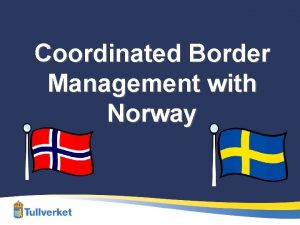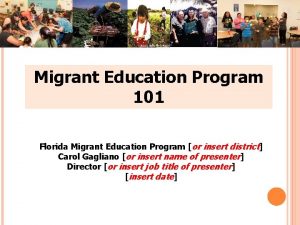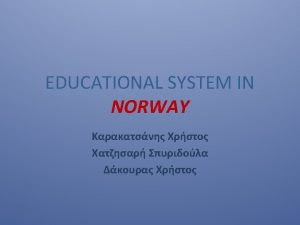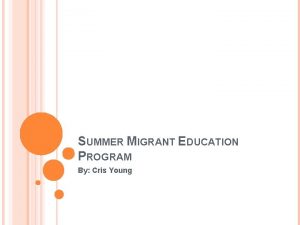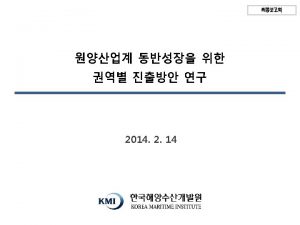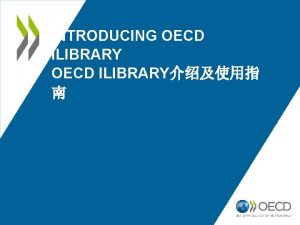OECD Reviews of Migrant Education Norway OECD DIAGNOSIS










- Slides: 10

OECD Reviews of Migrant Education: Norway OECD DIAGNOSIS AND POLICY RECOMMENDATIONS

Focus of the Presentation Today 1. Diagnosis: Key challenges for Norway 2. Some of the suggested policy options to address these challenges

Diagnosis: Key challenges for Norway Questions • Good balance between universal and targeted measures? • When targeted, … – who should be the priority target groups? – what should be the priority target areas to focus on?

Priority target groups Where can the biggest gaps be observed? Completion and retention in vocational upper secondary programmes - 2006 10 9 8 7 6 5 4 3 2 1 0 Participation in ECEC at age 3 - 2008 Completion and retention in general upper secondary programmes - 2006 Participation in ECEC at age 5 - 2008 Reading performance in primary school (Grade 4) 2006 Reading performance in lower secondary school (age 15) - 2006 Native students First-generation immigrant students Second-generation immigrant students Source: Statistics Norway 2008 (ECEC); PIRLS 2006 (Reading performance in primary school); OECD PISA 2006 (Reading performance in lower secondary school); Norwegian Directorate for Education and Training Completion and retention in upper secondary)

Priority target areas/factors What can be the factors that may explain the gaps? Socio-economic backgrounds Source: OECD PISA 2006 Language Note: statistically significant differences are marked in a darker tone.

A set of policy suggestions: Based on evidence of what works, and experiences of other countries 1. Early childhood education and care 2. Schools and communities • Teachers and school leaders • Language support • Vocational education • Learning environments at home 3. System management • Regional variations • Monitoring and evaluation

1. Early childhood education and care • Political will and financial commitment towards universal and affordable access for all Capitalising • Strong focus on language development in early years on… Norway could… Policy options • Improve access to quality early childhood education and care for all, especially immigrant children under age three. • Set up monitoring systems for access and quality in ECEC • Reduce economic barriers that discourage immigrant parents from participating in ECEC • Develop programs that work more closely with immigrant parents and communities

2. Schools and communities - Teachers and school leaders • Political support for raising teacher competencies and qualifications Capitalising on… • Encourage schools to be more responsive to the growing linguistic and cultural diversity of students. Improving the capacity of teachers and school Norway leaders is the top priority. could… Policy options • Train all teachers to be able to…. (Priority skills - formative assessment, second language acquisition, incorporating students’ cultures/previous experiences into teaching, working with families and communities) • Train school masters to lead in a culturally diverse setting. • Promote a whole-school approach in respect of migrant education.

3. System management– Regional variations • Strong commitment to local control Capitalising • Emerging system of accountability on… Norway could… Policy options • Strengthen accountability of schools and promote knowledge sharing among municipalities and schools. • Consider setting achievement targets for improving outcomes for immigrant students. • Support peer-learning opportunities and networking among teachers • Provide leadership and management training to municipality and county leaders

3. System management– Monitoring and evaluation • Participation in international testing and growing use of student assessment within the country Capitalising • Growing practice of evaluation, documentation of results and use of the results for improvement. on… Norway could… Policy options • Monitor progress and use formative evaluation at all levels – classroom, school and system. • Encourage municipalities to work with schools to use evidence of what works in a formative way at the system, school and classroom levels • Monitor concentration and alleviate potential negative effects though monitoring school capacity and evaluation of school practices
 Kansas migrant education program
Kansas migrant education program Definition of nursing process
Definition of nursing process Medical diagnosis and nursing diagnosis difference
Medical diagnosis and nursing diagnosis difference Second phase of nursing process
Second phase of nursing process Nursing process and critical thinking
Nursing process and critical thinking Perbedaan diagnosis gizi dan diagnosis medis
Perbedaan diagnosis gizi dan diagnosis medis Staar test directions
Staar test directions Florence owens thompson biography
Florence owens thompson biography Migrant mother analysis essay
Migrant mother analysis essay Pepsinogène
Pepsinogène St patrick's college peter skrzynecki poem
St patrick's college peter skrzynecki poem
